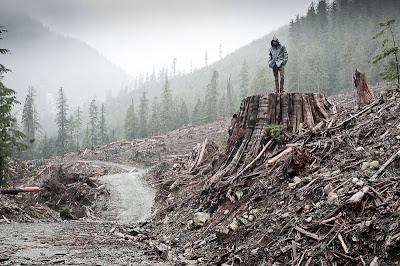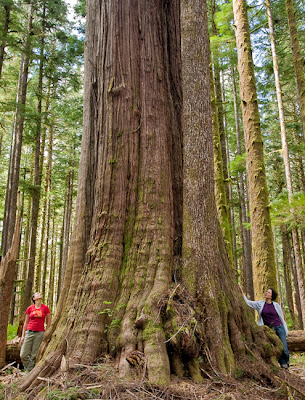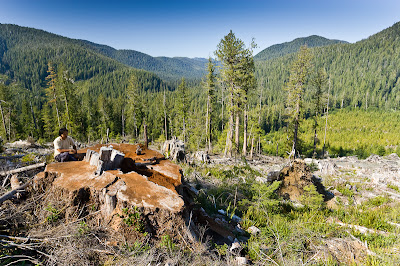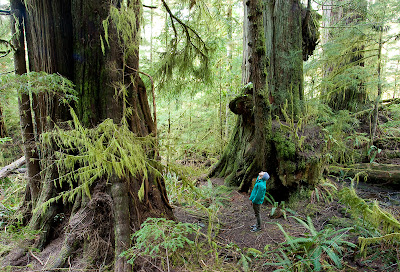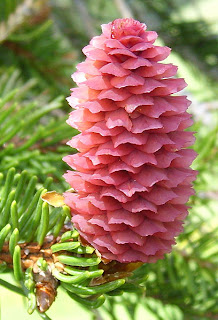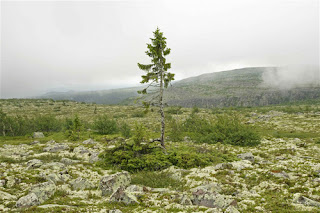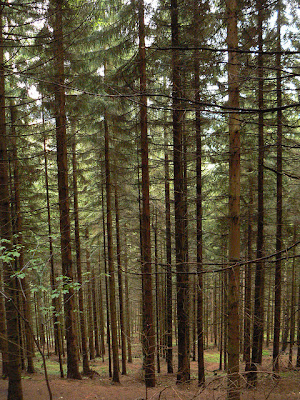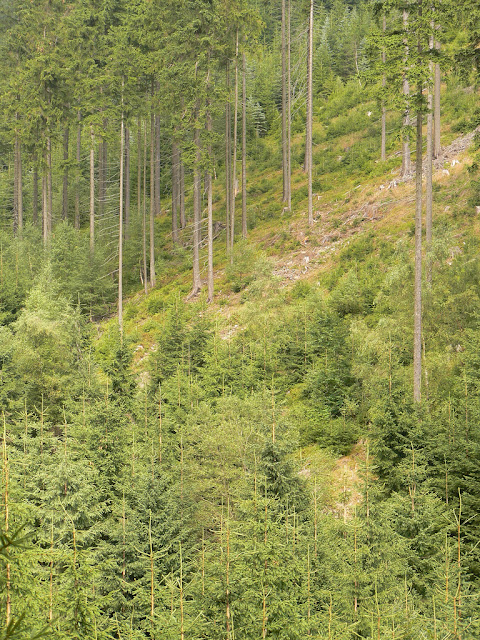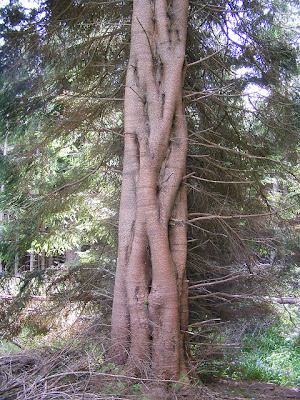| This mighty oak tree is between 400-450 years old with a circumference of 7.1 meters (a little over 23 feet) My son Tom is sat at the base of the tree chatting with Mark Krawczck Riven Wood Crafts an american forester, writer and researcher and fellow tree enthusiast |
When you have lived in the same area for quite some time (13 years in my case) you can tend to become a little complacent that you have seen all that their is to see in the locality. When a friend said that he had been to see a huge Oak tree only 15km away from here I was all ears and made arrangements with him to go and see it the next day.
We parked the car on the roadside and walked the 10 minutes or so down a tree lined old trackway to be confronted by an immense monster of an oak tree nestled in a sheltered valley. I was expecting something impressive but was not prepared for the sheer immensity of this beast of a tree. It is the type of tree that draws you in like a magnet and I couldn't resist immediatly planting my hands onto the deeply furrowed trunk.
The next task is trying to photograph this tree, you take a good few steps back to try to capture the collosal spread of the mighty limbs but it's still to big, you take a good few more steps back and it's still not far enough and just when I thought that I was going to get caught in the boggy ground alongside the Rau de Moulard which is the stream that flows close to the tree I was far enough back to more or less capture it full frame.
| This is your first glimpse of the enormous tree as you approach it. The grass is well maintained although some of the surrounding woodwork and the pic-nik table has seen better days. |
On arriving home I embarked on some internet research about thie history of this tree. A few minutes of digging around and I found that this tree is known as a Sully tree.
The Duke of Sully
Maximilien de Béthune, duc de Sully (1560-1641) was First Minister and right hand man of Henry IV of France. He was also passionate about trees and was responsible for halting and outlawing the devastation of the forests of France that had preceeded his appointment.
He was also a great planter of trees In 1599 he was appointed Grand Commissioner of Highways and Public Works amongst other titles. He ensured that trees were planted all along the verges of his new roads and it is said that he was responsible for starting the French tradition of planting roadside avenues of poplars, limes and elm trees (almost all of the elms have sadly been lost to disease) which are so characteristic of so many roads in parts of France.
In addition to this, he also according to some sources ordered (or at least instructed) the planting of individual trees in towns and villages often to commerate specific events, such as the birth of Henry's heir or even to honour the occasion of Henry IV just passing through a town or village, also for religious reasons or even just to celebrate the industrial success of France or to symbolise reconciliation and hope for the future.
The Duke of Sully
Maximilien de Béthune, duc de Sully (1560-1641) was First Minister and right hand man of Henry IV of France. He was also passionate about trees and was responsible for halting and outlawing the devastation of the forests of France that had preceeded his appointment.
He was also a great planter of trees In 1599 he was appointed Grand Commissioner of Highways and Public Works amongst other titles. He ensured that trees were planted all along the verges of his new roads and it is said that he was responsible for starting the French tradition of planting roadside avenues of poplars, limes and elm trees (almost all of the elms have sadly been lost to disease) which are so characteristic of so many roads in parts of France.
In addition to this, he also according to some sources ordered (or at least instructed) the planting of individual trees in towns and villages often to commerate specific events, such as the birth of Henry's heir or even to honour the occasion of Henry IV just passing through a town or village, also for religious reasons or even just to celebrate the industrial success of France or to symbolise reconciliation and hope for the future.
| Mark Krawczyk -Coppice Agroforestry stands on the huge fallen limb to inspect the hollow interior. My young son Tom is sat at the base of the old Oak. |
The trees that he was resposible for planting have become known as "Sully Trees" these were planted in places that were important to a community, such as near a church or where important markets took place. It is also noted that almost all of these commemerative trees are planted in tiny hamlets or small villages. It is not known wether these small communities were specially chosen by Sully or it is just the fact that it is only the trees located in quiet, out of the way places that have survived.
Following the assassination of Henry IV on 14th of May 1610 Sully resigned from state office on 26 January 1611, and retired to private life. Sully had never been popular in office, he was descibed as being selfish, obstinate and rude. He was hated by the Roman Catholics because he was a Protestant and by Protestants because he was faithful to the king and by almost everyone else also because he was the kings favourite. Sully, however was an excellent man of business and with time amassed a large personal fortune.
Following the assassination of Henry IV on 14th of May 1610 Sully resigned from state office on 26 January 1611, and retired to private life. Sully had never been popular in office, he was descibed as being selfish, obstinate and rude. He was hated by the Roman Catholics because he was a Protestant and by Protestants because he was faithful to the king and by almost everyone else also because he was the kings favourite. Sully, however was an excellent man of business and with time amassed a large personal fortune.
| The tree is hidden away in a quiet sheltered valley growing without competition on a rich deep soil with a large stream running nearby. |
He was implicitly trusted by Henry IV and proved himself the most able assistant of the king in dispelling the chaos into which the religious and civil wars had plunged France. To Sully, next to Henry IV, belongs the credit for the happy transformation in France between 1598 and 1610 a period when foreign peace and internal order were reestablished.
It is not known how many of these Sully trees survive still today, no definitive list of them appears to have ever been put together. I have seen one list with 130 or so of them but this in not thought to be complete. Another Sully tree still survives very close to me in a village called Bersac. This tree is a lime tree which although I must have driven past many hundreds of times I have never noticed or visited, a situation that is very soon to be rectified!
We have much to thank him for, including the planting of many millions of trees throughout France including this one. Quite why this tree was planted in this specific place so far still remains a mystery to me. It lies close to a modest chateau and perhaps the owners had an admiration for the king. At least the connection to Sully enables some sort of age to be established of somewhere between 400 and 450 years which was a little less than I would have estimated for an oak tree of this stature.
It has an impressive girth of 7.1 meters, The tree seems overal to be in pretty good health despite losing a huge lower limb, probably in December 1999 when we had winds approaching 140km/hr which were just too much for the tree to bare.
For whatever reason, this branch has not been cleared away and its presence adds to the charm of the site and also alerts you to the vulnerability and future mortality of this giant.
The sheering off of the branch has exposed a hollow and decaying interior which I expect will in some future decade be the trees downfall.
On the opposing side of the tree to the scar, sprouts an even bigger bough, almost the size of a normal mature broadleaved tree in its own right which I feel needs urgent propping and supporting to prevent it also breaking off. If this happened it would most certainly inflict the last fatal blow to this veteran survivor.
It is not known how many of these Sully trees survive still today, no definitive list of them appears to have ever been put together. I have seen one list with 130 or so of them but this in not thought to be complete. Another Sully tree still survives very close to me in a village called Bersac. This tree is a lime tree which although I must have driven past many hundreds of times I have never noticed or visited, a situation that is very soon to be rectified!
We have much to thank him for, including the planting of many millions of trees throughout France including this one. Quite why this tree was planted in this specific place so far still remains a mystery to me. It lies close to a modest chateau and perhaps the owners had an admiration for the king. At least the connection to Sully enables some sort of age to be established of somewhere between 400 and 450 years which was a little less than I would have estimated for an oak tree of this stature.
 |
| The wrenching off of the giant limb has exposed the decaying heartwood within the tree. |
For whatever reason, this branch has not been cleared away and its presence adds to the charm of the site and also alerts you to the vulnerability and future mortality of this giant.
The sheering off of the branch has exposed a hollow and decaying interior which I expect will in some future decade be the trees downfall.
On the opposing side of the tree to the scar, sprouts an even bigger bough, almost the size of a normal mature broadleaved tree in its own right which I feel needs urgent propping and supporting to prevent it also breaking off. If this happened it would most certainly inflict the last fatal blow to this veteran survivor.
View Chene du Sully a sazeirat - How to find it in a larger map
How to find the tree.
The tree is situated close to the chateau of Sazeirat in the commune of Arrenes (23210) on the western edge of the Creuse (department 23) in the Limousin region of France. As the crow flies it is situated just a few 100 meters from the D914 road that runs between Lauriere and Marsac. Please note that it is not signposted from the road.
Directions
From the D914 about 1 km to the west of Marsac take the D48 road towards Arrenes. After several hundred meters there is a bend in the road with a metal cross standing by the roadside on the right hand side of the road in a field boundary. (If you get as far as the chateau at Sazeirat you have gone too far!).
From the D914 about 1 km to the west of Marsac take the D48 road towards Arrenes. After several hundred meters there is a bend in the road with a metal cross standing by the roadside on the right hand side of the road in a field boundary. (If you get as far as the chateau at Sazeirat you have gone too far!).
Park the car here and walk down the prominant tree lined trackway for about 850 meters (half a mile) crossing a small wooden bridge over a stream. As you climb the hill after the stream, a path branches off to the left with a sign for the "Gros Chene". The tree lies about 100m away and is difficult to miss!
Some of the information on the Duke of Sully and his trees was found on this highly informative website http://sullystrees.weebly.com/index.html This is a site put together by Terry Brown from Bradford on Avon which is the twinned with Sully sur Loire in France. Terry has put a lot of effort and research into the quest for information on Sully trees for which I thank him for.
Some of the information on the Duke of Sully and his trees was found on this highly informative website http://sullystrees.weebly.com/index.html This is a site put together by Terry Brown from Bradford on Avon which is the twinned with Sully sur Loire in France. Terry has put a lot of effort and research into the quest for information on Sully trees for which I thank him for.


